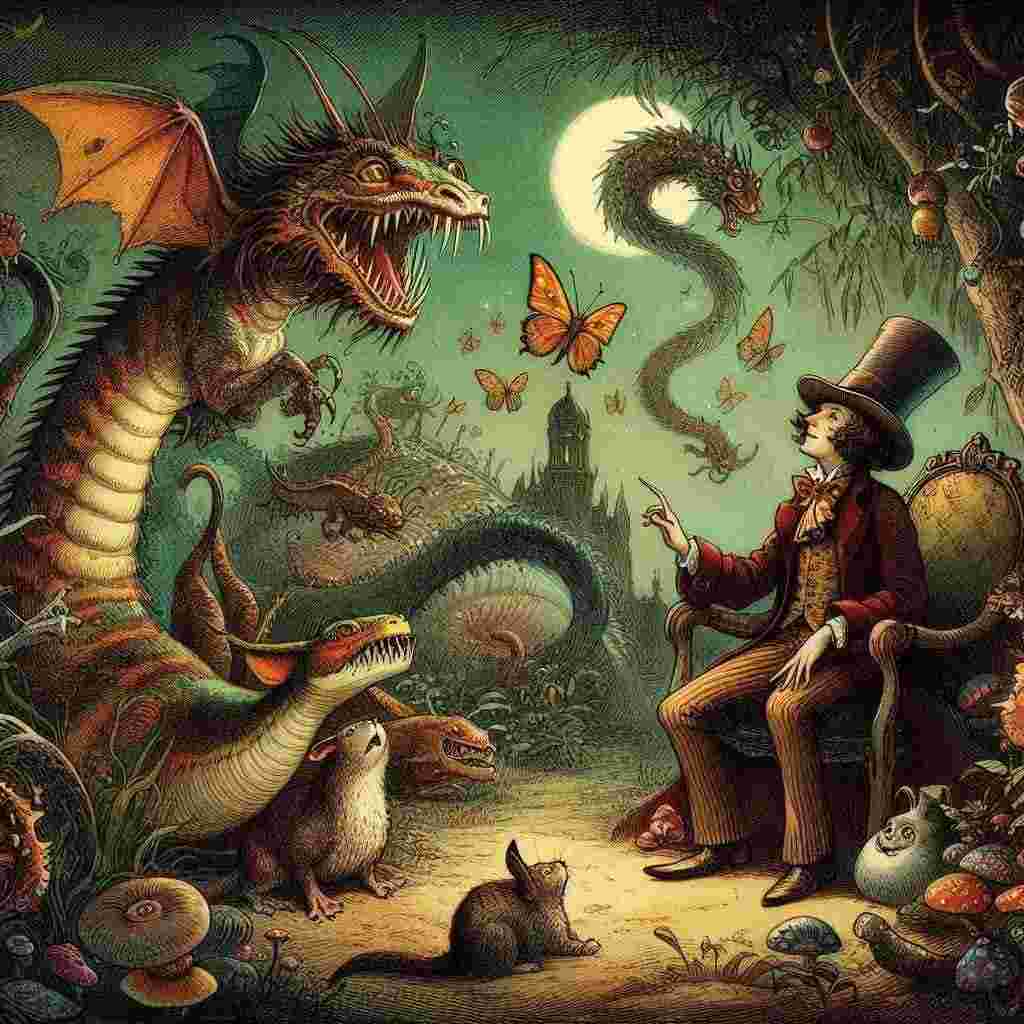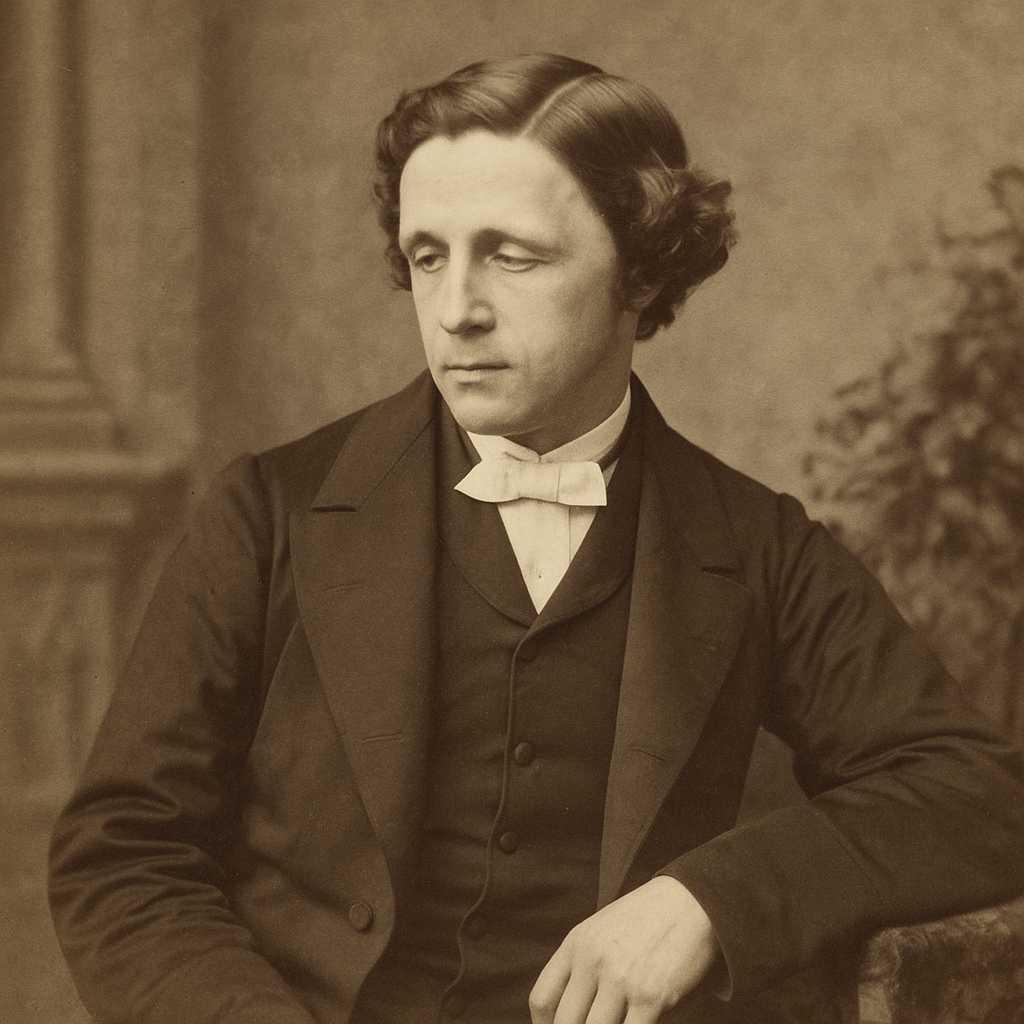Jabberwocky
Lewis Carroll
1832 to 1898

’Twas brillig, and the slithy toves
Did gyre and gimble in the wabe:
All mimsy were the borogoves,
And the mome raths outgrabe.
“Beware the Jabberwock, my son!
The jaws that bite, the claws that catch!
Beware the Jubjub bird, and shun
The frumious Bandersnatch!”
He took his vorpal sword in hand;
Long time the manxome foe he sought—
So rested he by the Tumtum tree
And stood awhile in thought.
And, as in uffish thought he stood,
The Jabberwock, with eyes of flame,
Came whiffling through the tulgey wood,
And burbled as it came!
One, two! One, two! And through and through
The vorpal blade went snicker-snack!
He left it dead, and with its head
He went galumphing back.
“And hast thou slain the Jabberwock?
Come to my arms, my beamish boy!
O frabjous day! Callooh! Callay!”
He chortled in his joy.
’Twas brillig, and the slithy toves
Did gyre and gimble in the wabe:
All mimsy were the borogoves,
And the mome raths outgrabe.
Lewis Carroll's Jabberwocky
Lewis Carroll's "Jabberwocky" stands as a quintessential example of nonsense verse in English literature, blending whimsical language with a heroic narrative structure. First published in 1871 as part of "Through the Looking-Glass, and What Alice Found There," the poem has captivated readers and scholars alike with its linguistic innovation and playful approach to storytelling. Carroll's masterful creation of neologisms and portmanteau words challenges conventional understanding while simultaneously conveying a clear and engaging tale.
The poem's structure follows a traditional ballad form, consisting of seven stanzas of four lines each, with an ABAB rhyme scheme. This familiar framework provides a stark contrast to the unfamiliar language used throughout, creating a tension between form and content that is central to the poem's appeal. The first and last stanzas are identical, forming a cyclical structure that suggests a return to normalcy after the fantastic events of the central narrative.
Carroll's inventive language is the most striking feature of "Jabberwocky." Words like "brillig," "slithy," and "outgrabe" are entirely fabricated yet manage to evoke specific sensory impressions through their phonetic qualities. This phenomenon, known as sound symbolism or phonaesthesia, demonstrates Carroll's deep understanding of the relationship between sound and meaning in language. For instance, "slithy" combines "slimy" and "lithe," suggesting a creature both slippery and agile. Such linguistic play not only entertains but also invites readers to actively engage with the text, deriving meaning from context and sound rather than relying on established definitions.
The narrative arc of "Jabberwocky" follows a classic hero's journey, despite its unconventional vocabulary. A young hero is warned of a fearsome creature, the Jabberwock, and sets out to confront it. The use of familiar tropes - such as the parental warning, the hero's quest, and the triumphant return - provides a structural backbone that allows readers to follow the story even when individual words are unclear. This juxtaposition of the familiar and the strange is a key element of the poem's enduring appeal.
Symbolism plays a significant role in "Jabberwocky," with the Jabberwock itself representing a generic monster or challenge that must be overcome. The "vorpal sword" wielded by the hero suggests a magical or powerful weapon, while the "Tumtum tree" evokes a place of rest or contemplation. These elements contribute to the poem's fairy tale-like quality, reinforcing its position within the broader context of children's literature and fantasy.
The poem's rhythmic quality and use of onomatopoeia further enhance its impact. Phrases like "snicker-snack" to describe the sword's action and "galumphing back" to depict the hero's return create vivid auditory imagery. This musicality not only makes the poem memorable but also contributes to its sense of playfulness and joy, particularly evident in the father's celebratory reaction to the hero's victory.
"Jabberwocky" has had a profound influence on literature and popular culture since its publication. Its inventive language has inspired numerous writers and linguists, with several of Carroll's neologisms, such as "chortle," entering common usage. The poem has been translated into multiple languages, each version presenting unique challenges in preserving both the nonsensical elements and the underlying narrative.
From a critical perspective, "Jabberwocky" can be interpreted as a commentary on language itself. By creating a coherent narrative using largely invented words, Carroll demonstrates the flexibility and power of linguistic structures. The poem challenges readers to question the relationship between signifier and signified, highlighting the arbitrary nature of language while simultaneously showcasing its ability to convey meaning through context and sound.
In conclusion, "Jabberwocky" remains a remarkable achievement in English literature, blending nonsense with narrative, innovation with tradition. Its enduring popularity stems from its ability to delight readers of all ages while offering rich material for literary analysis. Through its playful language, heroic story, and underlying commentary on the nature of communication, Carroll's poem continues to inspire and intrigue, cementing its place as a cornerstone of nonsense literature and a testament to the boundless creativity of the English language.
This text was generated by AI and is for reference only. Learn more
Want to join the discussion? Reopen or create a unique username to comment. No personal details required!



Comments
No comments yet. Be the first to comment!